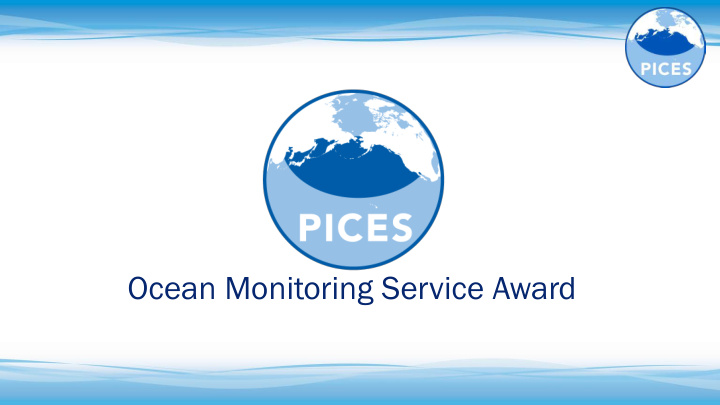



Ocean Monitoring Service Award
2017 POMA Award Recipient is:
2017 POMA Award Recipient is: Newport Hydrographic Line Circles indicate TENOC stations (1961-1972); crosses and dots indicate LTOP CTD sampling and crosses indicate chlorophyll/nutrient rosette sampling.
History of the Newport Hydrographic Line - 1 The Newport Hydrographic (NH) Line sampling along latitude 44 ° 39.1’N can be divided into four time periods based on differences in sampling frequency, spatial extent, range of variables and measurement methods, and funding source
History of the Newport Hydrographic Line - 2 1961-1972: “ The Next Ten Years of Oceanography ” (“TENOC”) era— bimonthly bottle sampling of temperature, salinity, and sometimes dissolved oxygen and nutrients out to 128W Hanging a Nansen bottle from R/V Yaquina, 1967 (D. Barstow Collection) 80 foot, 154-ton R/V Acona (1961-1964)
History of the Newport Hydrographic Line - 3 1972-1996: The “Process Study” era – strong seasonal info about upwelling made the NH line an ideal laboratory for the Coastal Upwelling Experiment and Coastal Upwelling Ecosystem Analysis programs (late 60’s to 70’s); the 1980s (except for 83) and early 1990s were very gappy on sampling 80 foot, R/V Cayuse 180 foot, 800-ton R/V Yaquina (1968-) (1964-1976)
History of the Newport Hydrographic Line - 4 1996-2004 The GLOBEC LTOP era (LTOP = “Long Term Observation Program”)—biweekly (spring through autumn) to monthly (winter) sampling along NH; station spacing was closer over the continental shelf; and many more variables were measured (targeting bacteria, phyto, micro, and zooplankton, forage fish, predatory 177 foot, R/V Wecoma (1976-2012) fish, cetaceans and seabirds); ship obs supplemented by fixed moorings, CODAR, and satellite sensing)
History of the Newport Hydrographic Line 2004-present “Gliders and Ocean Observatories” era—the historical data from NH Line led to successful Ocean Observatories Initiative (OOI) along NH Line with multiple instrumented buoys, bottom platforms (connected to powered underwater cables); fleets of gliders, etc. Time series of taxon resolved zooplankton and fish must still be done from vessels.
Scientific Impact Highlights Location and Spacing The NH Line fills a gap between three other longer established multi- disciplinary monitoring efforts : Line P/Stn P (1956- ) – off Southern Vancouver Island Vancouver Island Continental Margin (1979- ) CalCOFI (1951- ) – Southern California Bight NH Line is the only one providing high frequency (biweekly-monthly) sampling NH Line provides data for analysis of: Within year upwelling, El Nino/La Nina events, PDO decadal variability NH Line is in a region sensitive to the PDO variability
Scientific Impact Highlights Comparisons with Other Regions Between region comparisons within a single paper or book 28+ published papers Analyses/descriptions of conditions off central Oregon, that with other regional papers, for journal Special Issues on cross-region comparisons 14+ published papers In both of the above, the high spatial and temporal resolution of the NH Line enhanced their value in comparative studies.
Scientific Impact Highlights NH Line Zooplankton Time Series (32+ papers) Time series of copepod species richness (top panel) and zoogeographic affinity (bottom panel) off Newport, showing winter (and warm year) dominance by southern taxa, summer (and cool year) dominance by northern taxa. Data shown is from NH5 (5 miles from shore). Adapted from Hooff and Peterson (2006).
Scientific Impact Highlights Applications to Prediction of Fish Recruitment (23+ papers) Since 2006, the NWFSC has produced annual stoplight charts that characterize a suite of past years environments as good (green), neutral (yellow) or poor (red) and qualitatively forecast returns of coho (1 yr advance) and chinook (2 yr advance) salmon. The basis of forecasts are easily communicated to managers and clients.
Scientific Impact Highlights Other Major Science Contributions Importance of seasonal phenology in upwelling system (13+ papers) Continental margin hypoxia and anoxia (8+ papers or book chapters) Providing time-series and derived climatologies for initializing, validating or constraining numerical models (8+ papers) Education and Mentoring—trained many OSU Monthly near-bottom oxygen at NH-5 from students, some who have contributed to time 1960–71 (open circles) and 1998–2009 (x’s). Seasonality follows upwelling season. series elsewhere. Gray shading indicates hypoxia. From Pierce et al. 2012
Scientific Impact Highlights Sinc ince e 1967 and and cont ntinu inuing ing t to 2017, r res esear earch cond nducted ed and and dat ata a colle llect cted a d along t the N Newpo port Hydr drograph phic c line has b been integral t l to >120 pu 120 publica cations.
A Few of the Participants Contributing to NH Line Bill Peterson
In In me memoriam William T. Peterson 19 1942–2017 17
Recommend
More recommend